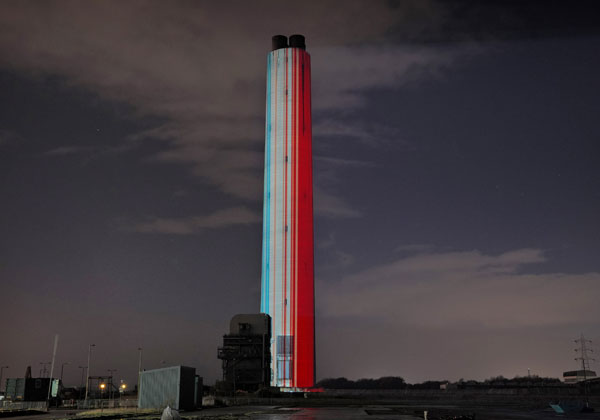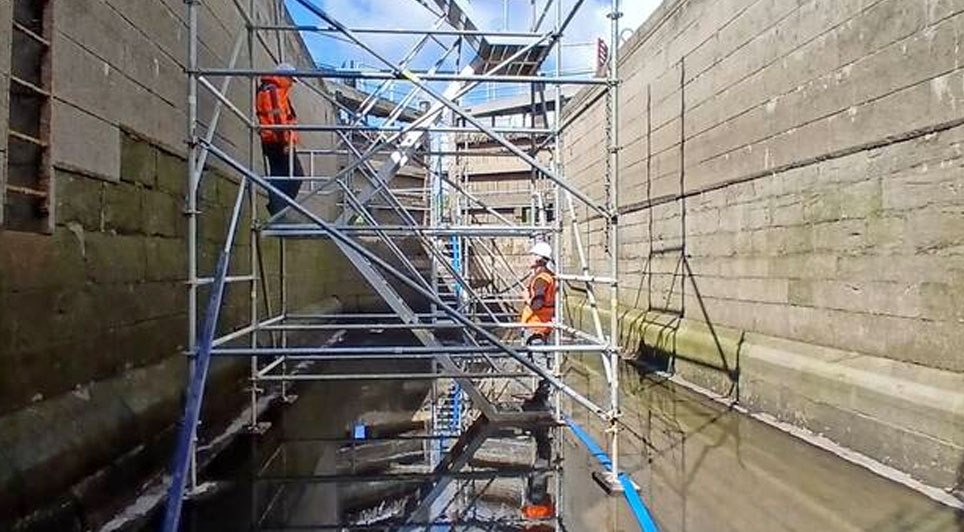Longannet's iconic 600ft chimney, part of Scotland's last remaining coal-fired power station, has been demolished in a controlled explosion, part of ScottishPower's journey to net zero emissions.
First Minister Nicola Sturgeon pushed the button to ignite 700kg of explosives, bringing down the chimney stack which has dominated the Firth of Forth skyline for more than 50 years and was, until today, the country's tallest freestanding structure.
The demolition of a major part of what was once the largest power station in Europe marks a significant step in the UK's transition from fossil fuel to renewable energy.
Scotland has been coal-free since ScottishPower closed the station in 2016. The energy company now only generates 100% green electricity through its wind and solar farms.
First Minister Nicola Sturgeon said: "Today's event is a symbolic reminder that we have ended coal-fired power generation in Scotland, as we work in a fair and just way towards becoming a Net Zero nation by 2045.
"Our goal is to generate 50% of overall energy consumption from renewable sources by 2030, and Scotland's energy sector is well placed to deliver on the key investments in renewables, hydrogen and energy storage required to achieve this.
"Growth in these sectors over the next decade will be transformative for Scotland, delivering further good, green jobs, strengthened energy security, and benefits for local communities as we decarbonise industry and society to mitigate the worst effects of climate change, in a way that leaves no one behind."
Keith Anderson, Chief Executive, ScottishPower said: "At COP26 in Glasgow, we were proud to show the world that Scotland has already made coal history. As a 100% energy company, we are committed to helping the UK end its reliance on fossil fuels.
"For half a century, Longannet's chimney has dominated the Firth of Forth skyline. We bade farewell to that landmark today – however this is a landmark day for Scotland too. Watching the chimney of Scotland's last coal-fired station fall today represents a real milestone, as the UK moves away from the large polluting power stations of the past and accelerates down the road to net zero emissions.
"We already know the transition from fossil fuels to renewable energy is essential to minimise the worst impacts of global warming and address the climate emergency."
Ignacio Galán, Chairman of ScottishPower and Iberdrola, said: "Longannet played an important role in Scotland's history as its largest coal station, but the future can only be about clean energy. Everyone working at ScottishPower and the wider Iberdrola Group should be proud to be contributing to this impressive transition from fossil fuels to renewables.
"This transition is essential to minimise the worst impacts of global warming and address the climate emergency. We made significant progress in Glasgow. Nice words or promises about 2040 or 2050 are not enough anymore, we need delivery. Iberdrola will continue to invest billions of pounds in renewables, smarter grids and storage to become net zero in Europe by 2030, providing abundant and competitive electricity and creating opportunities for industrial development and jobs across the value chain."
Beginning generation in 1970, Longannet Power Station at Kincardine-on-Forth in Fife was the largest coal fired power station in Europe when first built and remained Scotland's largest coal-fired power station until its closure by ScottishPower on March 31st 2016, marking the end of 47 years of fossil fuel production and ensuring Scotland's coal-free future.
At the height of operations, it burnt coal from around the world including Scottish open-cast coal and coal from as far away as Russia and Colombia. Typically, it consumed 4 million tonnes of coal per year and at full production could produce enough electricity to power two million homes.
Prior to the demolition event and following on from COP26 in Glasgow and its 'Climate Pact' to move the world further away from fossil fuels, ScottishPower projected the Global Warming Stripes onto the chimney along with the slogan 'Make Coal History' in a call to action for other countries to follow Scotland's lead.
Created by Professor Ed Hawkins of the University of Reading, they show the change in global temperature from 1850 to 2020, with shades of blue showing cooler-than-average years and red show years that were hotter-than-average.
ScottishPower is the UK's only integrated energy company which generates 100% green electricity from offshore and onshore wind. As a Principal Partner of the United Nations COP26 Climate Change Conference, ScottishPower is committed to supporting UK efforts to reduce coal consumption across the country.
It is developing an energy model that will play a significant role in reaching the UK's world-leading climate change targets and is investing £10billion in the UK over five years – £6 million every working day – to double its renewable generation capacity and drive forward decarbonisation to support the move towards net zero emissions.
Its plans include new solar, wind and battery infrastructure, green hydrogen facilities and undertaking the mammoth task of upgrading parts of the country's energy network to accommodate the expected rapid increase in demand for electricity.
The demolition of Longannet is being carried out by ScottishPower contractor Brown & Mason and work to remove materials at the site will continue into 2022.
Construction News
09/12/2021
Longannet's Iconic 600ft Chimney Demolished In Controlled Explosion


15/07/2025
Time is running out for residents to have their say on one of the most ambitious and high-profile developments proposed for Falkirk town centre in decades.
With just two weeks remaining before the consultation closes, Falkirk Council is urging people from across the area to share their views on the

15/07/2025
An award-winning principal contractor is celebrating the achievements of its staff as five team members reach 10 years with the company.
Hamilton-based firm, Procast Group, has recognised the longevity and excellent service of Gillean Watters, Brian Innes, Ryan Crawford, James Mimiec and Gabor Van

15/07/2025
Clark Contracts has successfully completed the design and build of a £30 million purpose-built student accommodation (PBSA) development on Mayfield Road in Edinburgh for Lanark Student Living.
The new facility, located directly opposite the University of Edinburgh's Kings Buildings campus, provides

15/07/2025
Scaffolding is set to rise around a prominent block of flats in Perth as Perth and Kinross Council begins a major structural maintenance programme aimed at preserving and improving its multi-storey housing stock.
The project is designed to ensure the buildings remain wind and watertight, energy-eff

15/07/2025
Farrans claimed success at this year's Construction News (CN) Awards after scooping Project of the Year in the £20m – £50m category.
The honours recognised the £29.5 million Govan to Partick Bridge project, for G

15/07/2025
The Eastern Green Link 2 (EGL2) project, a major joint venture between SSEN Transmission and National Grid Electricity Transmission, has reaffirmed its commitment to supporting the north-east economy, having already awarded over £9 million in contracts to businesses local to the project's northern l

15/07/2025
New research from Savills | Scotland Residential Development Market Summer 2025 warns that Scotland's housing market is facing a deepening crisis, as strict planning policies and rising development costs continue to stall new home delivery.
The housing emergency, declared in May 2024, has intensif

15/07/2025
Residents and businesses in Coatbridge are being encouraged to take part in an online survey to help shape the future of the town, as part of a major regeneration initiative backed by £19.5 million in UK Government funding.
The survey builds on community consultation held last summer and is designe

11/07/2025
Scottish Canals has announced that it is now halfway through its significant engineering programme on the Falkirk Flight of the Forth & Clyde Canal, an ambitious project spanning from locks 3 to 16.
This undertaking represents the biggest single investment in Scotland's canals since the Millennium

11/07/2025
The Construction Industry Training Board (CITB) has announced the elite line-up of finalists for SkillBuild 2025, bringing the nation's most promising construction trainees and apprentices one step closer to being crowned the best in their trade. Recognised as the largest and longest-running industr
 Scotland
Scotland UK
UK Ireland
Ireland London
London











